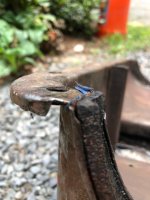Well within Tucker Tolerance for this preservation.at this stage based on what i see id just bite the bullet and rebuild that thing properly, crank looks terrible, block deck is beat, all that sludge is trapping debris etc, at the very least hot tank, deck, hone rings bearings and a quick bump on the seats grind valves
I pray my crank bearings look this good at 72 years





